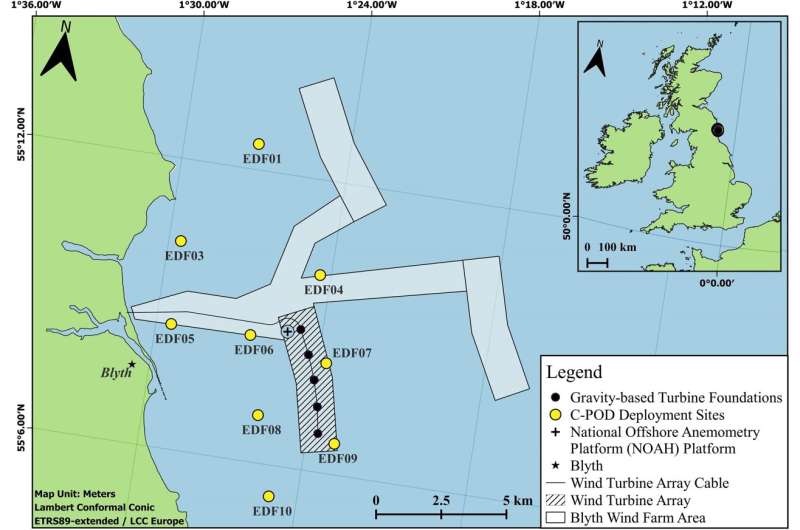This article has been reviewed according to Science X's editorial process and policies. Editors have highlighted the following attributes while ensuring the content's credibility:
fact-checked
peer-reviewed publication
trusted source
proofread
Gravity-based foundations: A marine-friendly future for wind turbines

Gravity-based structures may offer a porpoise and dolphin-friendly construction alternative to traditional pile-driven wind turbine foundations, new research suggests.
Marine scientists from Newcastle University investigated short- and long-term impacts of this new wind turbine installation method on cetaceans off Blyth, Northumberland. The response of dolphins and harbor porpoises was investigated using cetacean echolocation recorders over a three-year period, covering one year before, during and after the installation.
The findings revealed that wind turbine installation using gravity-based foundations had no long-term effects on the occurrence of dolphins or porpoises.
"Our findings are important in light of the global expansion of offshore wind farms and the need to find installation methods that have less impact to the marine environment," says lead author and master's graduate Kelsey Potlock. "These findings are promising for conservationists, marine environmental managers, and for the future of offshore renewable energy."
Published in the journal Marine Biology, the results show that the installation of wind turbines using gravity-based foundations had no long-term negative effects on dolphin presence, while porpoise occurrence increased by 32% and 75% during and after the construction phase, respectively, when compared to the pre-construction period. Other factors, such as month, hour of the day, tidal currents, and vessel sonar activity were found to influence the presence of dolphins and porpoises off Blyth.
Impact of wind developments on species and ecosystems
Offshore wind developments may cause physical and acoustic disturbance to marine ecosystems and species. Toothed whales like dolphins and porpoises use high-frequency echolocation signals to navigate their surroundings and locate prey and the noise generated by offshore construction activities can mask these signals, making it challenging for whales to accurately perceive their environment and find food.
Gravity-based foundations are large concrete structures that sit on the seabed and rely on their weight to provide stability for the wind turbine. They consist of a concrete base into which the shaft of the wind turbine is installed. They offer an alternative to traditional pile-driven installations, with less underwater noise and physical disturbance.
The study's senior author, Professor Per Berggren, chair of marine megafauna conservation at Newcastle University's School of Natural and Environmental Sciences, said, "Installation of wind turbines using gravity-based foundations could provide a more sustainable construction method for offshore wind developments. While the results are incredibly promising, we did observe a temporary decrease in dolphin occurrence during the construction phase, as well as a change in the daily activity patterns of harbor porpoises during and after construction, indicating a need for further investigation."
More information: Kelsey M. Potlock et al, Offshore construction using gravity-base foundations indicates no long-term impacts on dolphins and harbour porpoise, Marine Biology (2023). DOI: 10.1007/s00227-023-04240-1
Journal information: Marine Biology
Provided by Newcastle University


















